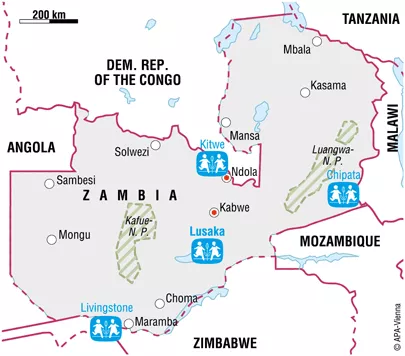
Zambian children face a harsh reality.
Thousands have been orphaned by AIDS and live a life without parental care, many of them in crippling poverty.
Access to primary education is nothing but wishful thinking in some regions of Zambia.
It is against this background that SOS Children's Villages decided to initiate its work in this South African country.
At present there are three SOS Children's Villages, two SOS Youth Facilities, three SOS Kindergartens, four SOS Hermann Gmeiner Schools, one SOS Vocational Training Centre, six SOS Social Centres and two SOS Medical Centres in Zambia. Another SOS Children's Village is under construction.
Please help us ensure a loving home for every child. Sponsor a child in Africa now.
For just $36/month you can sponsor a child in Zambia and help provide an orphaned or abandoned child with:
- A safe and nurturing home
- A loving SOS mother
- Quality education
- Healthcare
- Nutritious food
- Clothing and toys
- All the things necessary for a bright future
SOS Children's Villages in Zambia
In 1996, the national Zambian SOS Children's Villages association "SOS Zambia Trust" was founded. The organisation was provided with a plot of land in Lusaka, just a few kilometres from the city centre where we started working.
At present, SOS Children's Villages is supporting Zambian children and adolescents in three different locations by providing day care, education, medical assistance and vocational training.
The main focus of the SOS Family Strengthening Programme in the country is the HIV/AIDS epidemic. Zambian families affected by HIV/AIDS are supported by our organisation in order to strengthen existing family ties and enable children who are at risk of losing parental care to grow up within a caring family environment.
Children who cannot be taken care of by their own family can find a loving home in one of the SOS families.

Some facts about Zambia
The Republic of Zambia's total population is 13.8 million, of which roughly 50 per cent are under the age of 14.
While Zambia was once a thriving copper producing nation until gaining independence in 1964, it has now turned into an African poorhouse.
Zambia's colonial burden, political mismanagement and declining copper prices on the world market have been cited as the main reasons for the problems that the country has been facing.
Low life expectancy and high levels of poverty persist
When copper prices collapsed in the 1960s, Zambia's economic situation deteriorated rapidly. More than 60 per cent of the Zambian population now live in poverty. In rural zones, poverty levels are particularly high and access to even the most basic services such as running water, sanitation and decent housing is limited.
Despite the abundance of fertile land, Zambia experiences food shortages on a regular basis. The urban/rural poverty gap has been growing even further over recent years. In Zambia's national development plan, which outlines the government's vision regarding poverty reduction strategies, social protection is seen as a substantial pillar of growth.
However, its implementation remains a challenge. Quite often, households that are heavily affected by poverty are more vulnerable to HIV/AIDS, droughts and floods, changes in agricultural policies etc. Because of the socioeconomic environment that many Zambian are confronted with, life expectancy in the country remains low at only 47.3 years.
The extent to which the HIV/AIDS epidemic has been affecting Zambia is particularly worrying: at 13.5 per cent, the HIV-prevalence rate is among the highest in Africa. HIV/AIDS therefore remains a major public health concern in Zambia.
Situation of the children in Zambia
Children in Zambia represent a highly vulnerable segment of population. They are frequently neglected by their families, abused or pushed into harsh forms of labour that may include illicit drug peddling and petty work. Young girls are often forced to engage in commercial sex work in order to raise income for their families.
Although the legislative framework that is to protect Zambian children exists and is well stipulated, reality has shown that violations of children's rights remain one of Zambia's biggest challenges.
The main causes for child rights violations in Zambia are disintegrated families, their socioeconomic situation and the inadequate execution of existing laws.
1,300,000 children in Zambia have lost either one or both of their parents.
For children without parental care and those at risk of losing it, access to education remains difficult. Without education, the vicious circle that many children and adolescents experience is likely to continue once they become adults.
Over recent years, a number of campaigns aiming to reduce maternal and infant mortality have been launched. Current figures show that some of these campaigns have turned out to be successful: maternal mortality decreased noticeably from 729 to 591 per 100,000 live births.
690,000 Zambian children have been orphaned due to AIDS, a disease which remains one of the country's most pressing public health concerns. In Zambia, an estimated 490,000 women are HIV-positive. To prevent the mother-to-child-transmission of HIV via rigorous testing procedures and treatment programmes has been a health-care priority in Zambia. However, every day, a high number of children are born with HIV. Many of them die before their second birthday if they don't receive adequate treatment.
In a number of African countries, including Zambia, children are frequently accused of witchcraft. The severity of punishments varies: while some of these children are abandoned by their families and friends, others are tortured or even murdered.
Our Impact
Image
The SOS Children's Village in Zambia provides loving homes to orphaned and abandoned children |
4 VILLAGES | 628 Orphaned and Abandoned Children |
Image
The SOS Youth Facilities in Zambia provides youth with a loving environment where they learn to transition into independent living and to expand their education |
2 YOUTH FACILITIES | 178 Youths in our Care |
Image

The SOS Kindergarten in Zambia are a fundamental building block for the early development needs including, intellectual and social skills for children. |
4 KINDERGARTENS | 327 Kindergarten students |
Image

SOS Vocational Training Centres in Zambia provide young adults from our youth centres, SOS villages and the surrounding community with the skills they will need to secure reliable employment. They provide realistic job opportunities for the future and an avenue to independence. |
1 VOCATIONAL TRAINING CENTRES | 180 Youth and adult students |
Image

SOS Social Centres in Zambia aim is to help families, in particular women and children, living in communities neighbouring the SOS Children's Villages to gradually escape from poverty, and to help young people become self-reliant. |
4 SOCIAL CENTRES | 6743 Beneficiaries |
Image

SOS Medical Centres in Zambia provide quality health care to the children in our care, our staff, our staffís family as well as people in the surrounding community. |
3 MEDICAL CENTRES | 40314 Patients |
Our Impact





